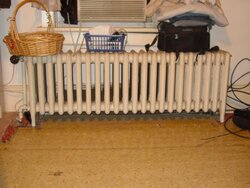Eric Johnson said:Marathon Furnace in Richford, NY (south or Cortland) makes a nice wood/coal/oil boiler in several sizes. I bought one new about 12 years ago and recently helped a friend install another new one. Old tech, I suspect, but it does get some secondary burn & has an ingenious grate design. Draft control is with a bimetal device, so no blower or need for electricity. I know where there's a leaky one that you could pick up cheap, assuming you know a very good welder.
I've got a Royall, circa 1980. There's a pic on here somewhere. They still make them the same out in Wisconsin. I'm in Clinton; let me know if you want to swing by to take a look sometime. The Royall can burn coal, too. It even has a place for electric coils. If push came to shove, you could probably poke an oil jet through the ash drawer door and heat some water that way. (You just heard my sales pitch for when I sell this house).
Ebay is always a good place to shop for used stuff like that. I've seen a number of used Tarms for sale, mostly over in New England. If money were no object (maybe it's not with you, LOL), then I'd take a serious look at the Tarm gassifier.
Eric, I have looked at the trams they are nice and very spendy for me.
I do weld so I would be interested in the marathon. Where is it located?
I am in Weedsport home of the Warriors class D football Champs!
When I moved in this house the old coal fired Peninsular beast was still in the basement. Someone had installed an oil gun in place of the ash doors; they used refractory cement to make a plate to attach it to.




